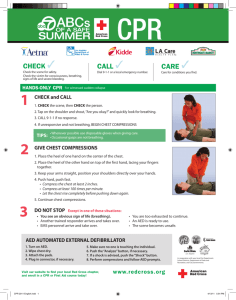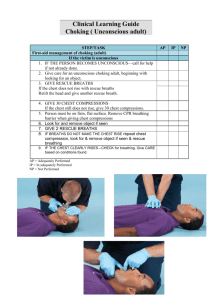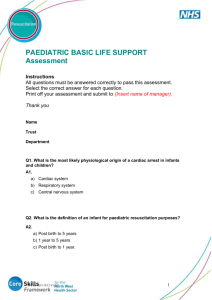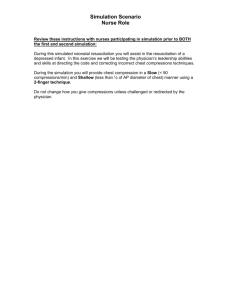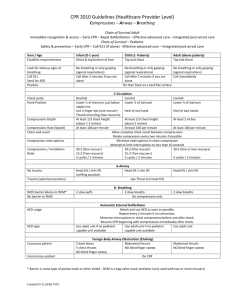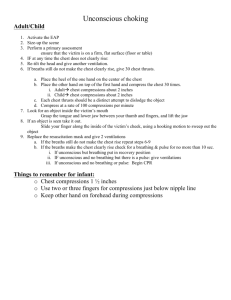CPR and First Aid - PrepareTheWayToday
advertisement
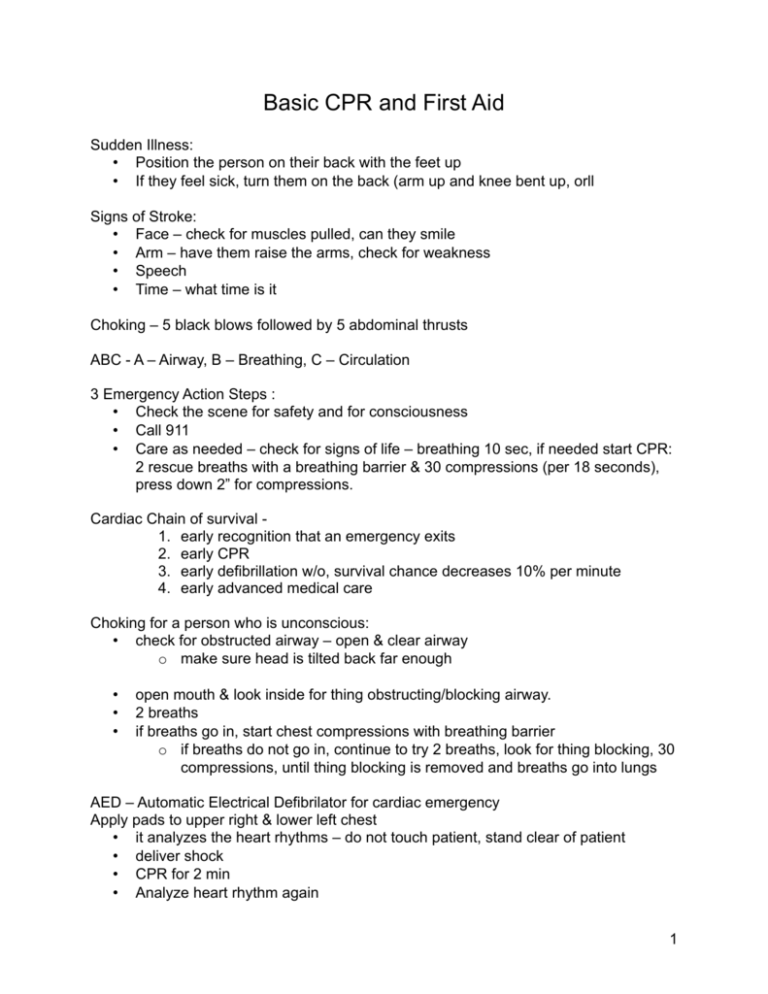
Basic CPR and First Aid Sudden Illness: • Position the person on their back with the feet up • If they feel sick, turn them on the back (arm up and knee bent up, orll Signs of Stroke: • Face – check for muscles pulled, can they smile • Arm – have them raise the arms, check for weakness • Speech • Time – what time is it Choking – 5 black blows followed by 5 abdominal thrusts ABC - A – Airway, B – Breathing, C – Circulation 3 Emergency Action Steps : • Check the scene for safety and for consciousness • Call 911 • Care as needed – check for signs of life – breathing 10 sec, if needed start CPR: 2 rescue breaths with a breathing barrier & 30 compressions (per 18 seconds), press down 2” for compressions. Cardiac Chain of survival 1. early recognition that an emergency exits 2. early CPR 3. early defibrillation w/o, survival chance decreases 10% per minute 4. early advanced medical care Choking for a person who is unconscious: • check for obstructed airway – open & clear airway o make sure head is tilted back far enough • • • open mouth & look inside for thing obstructing/blocking airway. 2 breaths if breaths go in, start chest compressions with breathing barrier o if breaths do not go in, continue to try 2 breaths, look for thing blocking, 30 compressions, until thing blocking is removed and breaths go into lungs AED – Automatic Electrical Defibrilator for cardiac emergency Apply pads to upper right & lower left chest • it analyzes the heart rhythms – do not touch patient, stand clear of patient • deliver shock • CPR for 2 min • Analyze heart rhythm again 1 CPR for Adults Cardiopulmonary resuscitation (CPR) combines rescue breathing with chest compressions to circulate oxygen around the body while waiting for further emergency help. CPR does not normally restart a person’s heart but when it is combined with early emergency help, early defibrillation (whereby a brief electric shock is given to the heart), and early advanced hospital care, it has saved many lives. Ribs may be broken during CPR but this is preferable to dying. GIVING CPR After providing the initial rescue breathing, you need to check the circulation to see if the heart is effectively pumping blood, and therefore oxygen, around the body. Look, listen, and feel for breathing, coughing, movement, normal color or any other sign of life for not more than 10 seconds. If there are no signs of circulation, or you are at all unsure, start chest compressions. These must be given with the victim lying on his back on a firm surface. ABC OR RESUSCITATION Airway Use head tilt and chin lift to keep the airway open while provide rescue breathing. Breathing Provide rescue breathing to somebody who is not breathing. Circulation Check for signs of circulation and combine rescue breathing with chest compressions if you think the heart has stopped beating. CHEST COMPRESSIONS 1. With your lower hand, locate one of the bottom ribs. Slide the fingers of one hand along the rib to the point where the rib meets the breastbone. Place one finger at this point and the finger next to it above it on the breastbone. Place the heel of your other hand on the breastbone and slide it down until it reaches your index finger. This is the point at which you should apply pressure. 2. Place the heel of your first hand on top of the other hand and interlock your fingers. Lean well over the victim and, with your arms straight, press down vertically and depress the breastbone one-third of the depth of the chest, which on an adult is at least 2 inches. 3. Release the pressure without losing contact between your hands and the breastbone. Compress the chest 15 times, at a rate of 100 compressions per minute. Compression and release should take an equal amount of time. 2 COMBINING CHEST COMPRESSIONS WITH RESCUE BREATHS Chest compressions circulate blood to the vital organs such as the brain. To ensure that this blood contains oxygen, you need to combine chest compressions with rescue breaths. After 15 compressions, tilt the head, lift the chin, and give 2 effective breaths. Continue until: • Emergency help arrives. • The victim shows signs of circulation. • You become so exhausted you cannot carry on or or someone relieves you. To save really need AED and advanced medical care. You have a ten minute window to help save the person. You have implied consent when person collapses in front if you IF THE VICTIM VOMITS The combination of being unconscious with no muscle tone to hold in the stomach contents, air possibly being blown into the stomach through rescue breathing, and compressing the chest may result in the victim being sick. He or she will often have lost the reflex that causes gagging so the vomit may stay at the back of the throat or come into the mouth. This must be cleared promptly: • Roll the person toward you, supporting the head. • Open the mouth and sweep out any vomit with two fingers. • Turn the person onto his back and start the ABC process again. You may wish to use a face shield when providing rescue breathing, but not having one should not stop you performing CPR. You can also give breaths through a handkerchief. CPR for a Child or Baby IF a child or infant has no pulse and is not breathing you will need to give CPR (cardiopulmonary resuscitation) to enable the body’s vital organs to continue functioning. After providing the initial rescue breathing, check the circulation to see if the heart is effectively pumping blood, and therefore oxygen, around the body. Look, listen, and feel for breathing, coughing, movement, normal color, or any other sign of life for no more than 10 seconds. If there are no signs of circulation, or if you are at all unsure, start chess compressions. This must be given with the child lying on their back on a firm surface. CHEST COMPRESSIONS FOR CHILDREN These techniques broadly apply for a child between 1-7 years old. However, you should take into account the size of the child 3 when deciding whether to use the techniques for children or infants. 1. Place the heel of one hand on the lower half of the breastbone. Lean well over the victim and, with your arm straight, press vertically down and depress the breastbone one-third on the depth of the chest – about 2 inches. 2. Release the pressure without losing contact between your hands and the breastbone. Compress the chest 5 times at a rate of 100 compressions per minute. Compression and release should take an equal amount of time. COMBINING CHEST COMPRESSIONS WITH RESCUE BREATHING FOR CHILDREN Chest compressions circulate blood to the vital organs such as the brain. To ensure that this blood contains oxygen, you need to combine chest compressions with rescue breathing. The procedure is the same as CPR for an adult but the chest compressions are not as forceful and the rate of breaths and compressions is different. After 5 compressions, tilt the head, lift the chin and give 1 effective breath. Continue this cycle of CPR. Do not interrupt the CPR sequence unless the child makes a movement or takes a breath on her own. Continue until: • Emergency help arrives and takes over. • The child shows signs of circulation. • You become so exhausted you cannot carry on. (Try to find someone to take over until medical help arrive.) CHEST COMPRESSIONS FOR BABIES These techniques broadly apply for a baby under 1 year. However, a large baby may require the techniques for a child and a small child may be better with the techniques for a baby. 1. Place the two fingers of one hand on the lower half of the breastbone, Lean well over the baby and, with your arm straight, press vertically down and depress the breastbone one-third of the depth of the chest. 2. Release the pressure without losing contact between your hands and the breastbone. Compress the chest 5 times at a rate 100 compressions per minute. Compression and release should take an equal amount of time. COMBINING CHEST COMPRESSIONS WITH RESCUE BREATHING FOR BABIES Chest compressions circulate the blood to the vital organs, and to ensure that this blood contains oxygen, chest compressions need to be combined with rescue breathing. After 5 compressions, lift the baby’s chin and give 1 effective breath. 4 Continue this cycle of 5 compressions to 1 effective breath. Do not interrupt the CPR sequence unless the baby makes a movement or takes a breath on her own. Continue until • Emergency help arrives and takes over. • The baby shows signs of circulation. • Somebody can take over from you if you are exhausted. First Aid TREATMENT FOR AN ADULT WHO IS CHOKING If the victim is able to speak or cough, then the situation is less serious. Encourage him or her to continue coughing if able. Check the mouth to see if any obstacle can be easily removed. Do not sweep in the mouth blindly, and take great care not to push down into the throat. If at any time the person show signs of becoming weak, stops breathing or coughing, or begins to lose color and turn blue, perform the Heimlich maneuver immediately. THE HEIMLICH MANEUVER The purpose of this maneuver is to displace any obstruction blocking the windpipe by forcing a cough. Stand or kneel behind the casualty and put both arms around the upper abdomen. Clench your fist and place it, thumb side in, between the belly button and the bottom of the breastbone. Grasp it with your other hand. Keep your arms away from the ribcage and pull sharply inwards and upward 4 times. This movement thrusts the diaphragm up toward the lungs, creating a cough. For a casualty who is lying down or unconscious, place the heel of one hand just below the breastbone. Place the other hand on top and give 4 short, upward thrusts. If the obstruction is still not relieved, repeat the maneuver. Recheck the mouth for any object that can be reached with a finger and remove it if possible. Perform the maneuver 3 times, then call for emergency help. WHAT IF THE PERSON BECOMES UNCONSCIOUS? Open the airway by tilting the head, checking the mouth, and lifting the chin. If the victim is breathing, falling unconscious might have freed the object sufficiently to allow air through. Turn the person into the recovery position, maintaining a careful check on breathing. If the victim is not breathing, provide rescue breathing and move on to the normal CPR procedures. 5 If you know that the person has choked and the chest does not rise when rescue breathing is attempted, move straight to chest compressions without assessment of circulation. Check the mouth after every set of compressions. The chest compressions act as an artificial cough and may help expel the object from the windpipe. Make sure that you call for emergency help as soon as possible. CHOKING IN CHILDREN Choking is a major cause of death in young children and should be considered whenever a child has breathing difficulties. Look for small beads or coin that the child may have been playing with, or ask playmates to identify clues that choking may be the cause of unconsciousness in the child. TREATMENT Check child’s mouth for obstruction but do not feel blindly in the mouth as you may push the object further into the windpipe. Look to see if there is anything that can be easily removed. If the child is breathing, encourage her to continue coughing because this may dislodge the obstruction. If the child shows signs of becoming weak or stops breathing or coughing, perform the Heimlich Maneuver. THE HEIMLICH MANEUVER This maneuver works by producing an artificial cough that dislodges the object blocking the windpipe. Stand or kneel behind the child. Put your arms around her waist. Make a fist with one hand and place it, between the belly button and the bottom of the breastbone. Grasp the fist with your other hand. Keep your arms away from the child’s ribcage and give 4 sharp inward thrusts. The aim is to relieve the obstruction with each thrust. It may be necessary to repeat this maneuver before the object is coughed up. If the obstruction is still not relieved, recheck the mouth for any object that can be reached with a finger and remove it if possible. Perform the maneuver 3 times before calling for emergency help. CHOKING IN BABIES Babies under one year are most likely to choke on their vomit. Look in the mouth. If you can easily remove the cause of the problem, then do so, but take great care not to touch the back of the throat or to push the object further in. Perform the Heimlich maneuver on a baby by positioning it face down along your arm. Support the head with your hand .With the heel of your hand. With the heel of your hand, give 4 sharp blows to the back. It may be necessary to repeat this procedure before the obstruction is cleared. 1. Position the baby so that the head is downward. Apply 4 sharp blows to the back with the heel of the hand. Check the mouth carefully for the object. You may need to repeat the 6 cycle until the obstruction is coughed up. If giving back slaps does not dislodge the object, you will need to perform chest thrusts. 2. To give chest thrusts turn the baby over and place two fingers one finger width below the nipples. Give 4 sharp thrusts to a depth of 1 inch. It may be necessary to repeat until the object is coughed up. Call for emergency after repeating the cycle 3 times. WHAT IF THE CHILD OR BABY BECOMES UNCONSCIOUS? Begin CPR. If the infant is not breathing and the chest does not rise when rescue breathing is attempted, move straight to chest compressions with assessment of circulation. Check the mouth every set of compressions. Cuts with bleeding 1. cover wound and apply pressure until bleeding stops, secure bandage 2. roller bandage & tape or tie off, pressure untikl EMS arrives 3. don’t remove foreign object, bandage around would If you come in contact with blood, wash hands immediately after care, even if gloves were on! Try to care for victim where they are unless they are in immediate danger, or you need to treat others more severe ---- then move. Support & Move: 1. with their arms around your neck and supported on your back – carry them 2. human crutch - arm around waist – their arm around your neck 3. pack strap carry – cross their arms 4. 2 person seat carry 5. clothes drag if head or neck injury is suspected, head up & get a hold of clothes on back at shoulders If moving an injured or ill person is absolutely necessary, encouraging him to move by himself is by far the best approach, minimizing risk to both you and him. However, this is not always possible. There are a number of dangers inherent in lifting and moving people and the task should not be undertaken lightly. The following techniques require no real equipment and in an emergency situation can be very effective. 7 ONE-PERSON CARRIES The human crutch If you find yourself in a situation where the injured person has, for instance, sprained an ankle and is having difficulty in walking, this technique will provide additional support if nothing else, such as a walking stick or crutch, is available. 1. Stand on the person’s injured or affected side, pass her arm around her waist and grasp her hand or wrist. 2. Place your other arm around her waist and grasp her clothes, preferably the top of the trousers or a belt. 3. Move off with your inside foot first, walking at the victim’s pace. Piggy back Although this is an effective carry, how far you will be physically capable of moving the victim will depend on her size and weight. It is also reduces your ability to carry your won equipment, particularly if you are hiking with backpacks. 1. Crouch in front of the victim with your back toward her and ask her to put her arms over your shoulders. 2. Grasp the victim’s thighs, pull them in toward you and slowly stand up, remembering to keep your back straight. The drag This technique is really for extreme emergencies and will be effective only over short distances as it is very labor-intensive. Its key use is in moving people from very hazardous areas quickly. 1. Crouch behind the victim. Carefully pull him toward you. Stop, take a step back, and pull the victim toward you again. 2. Repeat this procedure until you have reached your destination. TWO-PERSON CARRIES It is far easier for two people to control and move someone. However, these techniques do have their limitations, even with two people, and require a little practice. 8 Two-handed seat carry 1. Crouch down, facing each other on either side of the injured person. 2. Cross over your arms behind the victim and grab hold of her waistband or belt. 3. Pass your other hands under the victim’s knees and grasp each other’s wrists. 4. Bring your hands toward the middle of the victim’s thighs. 5. Get in close to the injured person and stand up slowly; you are now ready to move off. FOUR-HANDED SEAT CARRY The two-handed and, in particular, the four-handed seat carries can only be used with conscious people because they require the person being carried to have some control over her body and give some assistance to the rescuers. 1. With the person to be carried standing close to you, first hold your left wrist with your right hand, and ask your carrying partner to do the same. 2. Now, link hands, taking hold of your partner’s right wrist. This should form a square. 3. Allow the victim gently sit back onto your hands and get her to place her hands around your shoulders. It should be noted that this is extremely strenuous and awkward for the rescuers. Soft Tissue Injuries Burns from: • Heat, fire, steam, hot liquids • Electricity • Chemicals – use plenty of running water • Explosions • Radiation (even sun) 1. cool under cold running water 2. cover with gauze, bandage Muscles, Bones, Joints • Broken bones – check injured area, check for feeling, check color & warmth 9 • Strained muscles or sprained joints – if cannot use the body part, suspect that it is broken and splint it. To splint, leave the injury in the position you find it in o Anatomic - use a body part to splint it to; check for feeling in the injured part o Soft material to make a splint, i.e. a sling; check the injured area, check for feeling, warmth and color o Rigid splint – cardboard, newspaper, piece of wood to splint to; support injured area, check feeling, warmth & color, recheck after splinted; Splint above and below injured area RICE R – rest I – ice C – cold barrier between ice & skin E – elevate Controlling Soft Tissue Bleeding Wound • Closed bleeding wound that leads to bruising – apply cold pack on wound • Internal bleeding wound – serious, take to hospital • Open bleeding wound – clean & stop the bleeding with pressure on or above the wound and disinfect When exposure incident to blood – flush eyes, nose mouth with lots of water, wash blood off hands or other body parts with soapy water and disinfect Allergic reactions to insect stings, food, latex which can cause anaphyaxis: • Remove stinger and apply a cold pack to hinder swelling • Get Benadryl immediately or if life-threatening use the Eppy pin (epinephrine) auto injection 10
